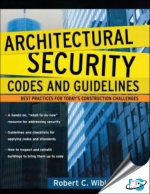Tab Article
In-depth, “what-to-do-now” building strategies to secure structures against natural forces as well as terrorism
This unique, practical resource is written for building owners, architects, engineers, construction managers, and other building professionals who must meet today's urgent security needs. Architectural Security Codes and Guidelines delivers effective, permanent solutions to securing structures right now.
The only resource to provide such on-the-job guidance, Architectural Security Codes and Guidelines defines all relevant issues, including the environment, sustainability, energy, information technology, changing demographics, safety vs. affordability, and much more, and outlines the roles and responsibilities of all participants.
- Provides step-by-step “best practices” guidelines and at-a-glance checklists for disaster preparation, mitigation, response, and recovery
- Fully addresses topics such as risk-threat assessments, recommended HVAC systems and emergency generators…how to ensure that the elderly/handicapped can exit buildings quickly and safely…more
- Lists the newest technologies and materials relevant to creating more secure structures…explains their advantages and disadvantages…tells how to incorporate them into new construction and/or use them for retrofitting


